The Westside’s too “social” party scene
April 11, 2012
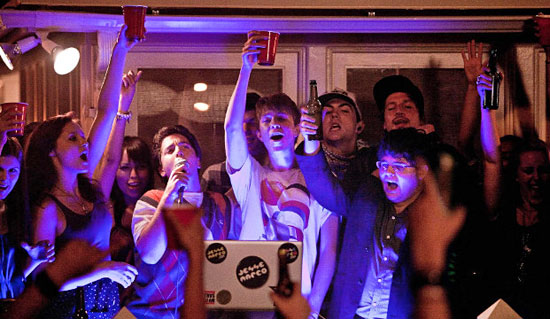
Police suspect that the movie "Project X" inspired the free-for-all parties in Pacific Palisades and Holmby Hills.
Talk about paradise lost.
While vacationing in Hawaii two weeks ago, a Pacific Palisades teenager learned from postings on his Facebook page that he was missing a party—at, gulp, his own house. The boy had unwittingly opened the door by letting his Facebook “friends” know that he and his family would be out of town.
“The father called us from Hawaii saying that something might be going on at his home,” recalled Los Angeles Police Officer Raymond Barron. That was an understatement. The house had been broken into and trashed by a crowd of drinking, partying young people, some of whom allegedly stole laptops and sound equipment. Eleven juveniles and 2 young adults were arrested.
Meanwhile, also on the Westside that same weekend, more than 500 partyers overtook an apparently vacant home in Holmby Hills after they’d been chased out of a house by police in Beverly Hills. Once again, word of the roving party had spread instantaneously through Twitter and other social media. It took nearly an hour for officers, who made numerous arrests, to clear the revelers who’d streamed into the quiet neighborhood “like a swarm of bees,” according to one resident.
Members of the LAPD’s West Los Angeles Area are, of course, no strangers to the occasional big, unruly party that might get going near UCLA or in large homes rented out for the night, said Officer Barron. But the two “flash mob parties” that occurred on the weekend of March 31 represented a troubling twist on the party scene, one that Police Chief Charlie Beck said requires some basic digital-age precautions. Perhaps most important: “If you’re going to be absent from your residence,” the chief said, “don’t put it on social media.”
In a “community alert” this week, the West L.A. station’s crime analysis detail said there appeared to be a link between social media-fueled parties and the release of “a particular movie.” In the most recent cases, the department has speculated that “Project X” may have served as inspiration. The movie, released in March, is about three friends who plan on becoming popular by throwing a raucous party that quickly escalates out of control.
Or as one blurb said of the movie’s plot: “A parent’s worst nightmare.”
Posted 4/11/12
Celebrating a hundred years of Woody
April 11, 2012
Few musicians have had broader influence than the late Woody Guthrie, an American folk hero who inspired generations of music-lovers and activists. To celebrate the 100th anniversary of Guthrie’s birth, University of Southern California is hosting “Woody Guthrie’s Los Angeles: A Centenary Celebration” this Saturday, April 14.
The free conference will feature scholars, musicians and writers who will focus on Guthrie’s Depression-era rise to fame in Los Angeles through a series of discussions, interviews and performances. The conference is a collaboration of the Grammy Museum, the Woody Guthrie Archives and four universities.
Reservations are required for the event, which begins at 8 a.m. with coffee and pastries and concludes at 5:15 p.m. after Bob Santelli, executive director of the Grammy Museum, interviews a “special guest.” It all takes place in Bovard Auditorium at USC— directions are available online.
Following the event will be a concert tribute to Woody Guthrie at Club Nokia. Featured artists include Jackson Browne, Crosby and Nash and Kris Kristofferson. Tickets to the concert range from $39.50 to $99.50 and may be purchased online.
Posted 4/12/12
How UCLA aced its traffic test
April 11, 2012
They said it couldn’t be done. Some said it shouldn’t be done. Yet to the surprise of many, it got done—a vast expansion of UCLA’s facilities without an equally vast increase in cars moving into and out of the campus.
In fact, more than two decades after the university embarked on a long range plan to add millions of square feet to its Westwood campus, the number of trips in and out of UCLA each day stands at its lowest point since such record-keeping began in 1990.
What’s more, it appears that the university’s culture of transportation has changed, too, with just under 53% of its employees driving alone these days—compared to nearly 72% in the county as a whole, according to the university’s latest “State of the Commute” report. The number of those taking public transportation to and from campus has doubled in the past decade—due in large part to a generous bus pass subsidy program that’s funded by parking and citation revenue. The university’s vanpool program is large and visible. And BruinBus, the free, cross-campus shuttle, clocked more than 1.2 million trips last year.
“I love the BruinBus,” said Scott Morrison, a senior majoring in history who lives near campus in a fraternity. “Most people I know don’t have cars.”
Certainly, cars are still a major fact of life in Westwood—with congestion levels there among the worst in the city.
That makes it all the more improbable that an institution in the eye of L.A.’s traffic storm would be able to transform itself into a laboratory for alternative transportation solutions. And those efforts, oddly enough, were inextricably linked to the university’s ambitious, and controversial, growth plans.
Between 1990 and 2011, university officials estimate that campus square footage increased by 66%—from 10.4 million square feet to 17.3 million. Although the new buildings included the Ronald Reagan UCLA Medical Center, the Anderson Graduate School of Management and the Terasaki Life Sciences Building, much of the new construction has been for student housing. So even though UCLA’s student population went from 36,427 in 1990 to 40,675 last year—an increase of less than 12%—the percentage of students living on campus rose far more dramatically, from 12% to 29%.
The university’s evolution from commuter campus into a more residential environment means that more than 29% of students now walk to school. Among them is Erika Gonzalez, a first-year biology student, who said that getting from her dorm to class is a cinch.
“I just go down a little hill and I’m there,” she said. “I just walk everywhere.”
And not having a car—it’s prohibited for dorm residents unless a student has an off-campus job or paid internship—has become business as usual.
“Cars kind of become communal things,” said Holli Herdeg, a first-year Greek and Latin student who said dorm-dwellers turn to friends who live in apartments when they need a lift off campus.
A key turning point in the university’s transportation evolution came in 1990, when then-Chancellor Charles Young agreed to something that was relatively novel at the time: city-imposed caps on the number of trips into and out of campus that, if exceeded, would bring new development to a halt.
“Chuck said, yeah, I can live with that. All of his people, their mouths dropped open,” recalled Supervisor Zev Yaroslavsky, who at the time was a Los Angeles City Councilman representing the area.
“For us down in the trenches, it was a little bit of a gulp,” said Renée Fortier, the executive director of UCLA Events & Transportation, who at the time was the university’s associate director of transportation services. “We agreed with the city that we would measure every single trip into and out of the campus. If we went over, all construction would stop. It wasn’t an agreement that didn’t have teeth.”
A wide-ranging building program on campus was essential, Young said at the time, to keep and expand the university’s standing as a top-tier research university.
But community groups had serious concerns.
“This idea of not producing traffic is a bad joke,” Laura Lake, then president of Friends of Westwood, said skeptically at the time.
Today, Lake sees some positive signs, including the university’s vanpool program and its efforts to house more students on campus. But she questions whether the methodology provides an altogether accurate accounting of UCLA’s overall impact on traffic because it doesn’t include off-campus university-owned buildings in Westwood. “Unless one looks at the whole enchilada, you don’t know what you have,” said Lake, currently co-president of the group Save Westwood Village.
(The university said that the vast majority of employees who work in its Wilshire Center or in leased space elsewhere in Westwood park in UCLA-owned parking facilities and are counted as part of its daily trip averages.)
Sandy Brown, president of the Holmby-Westwood Property Owners Association, added that whatever the numbers show, the experience of driving through Westwood Village is still a “disaster,” especially during afternoon rush hour.
“There’s reality, and then there are studies,” she said. “I would tell you that the studies don’t match reality.”
For his part, Young believes the university succeeded beyond expectations on two difficult fronts by expanding the square footage on campus more than it had initially envisioned and reducing traffic “even more than we thought we would.”
“We knew it wasn’t going to be easy,” he said recently, “but there were actions that we could take that would guarantee or at least make it likely” that UCLA would stay within the agreed-upon limits.
The university, limited by the city of Los Angeles to 139,500 trips to and from the campus each day, got as high as 125,792 trips in 2003 before dropping to the record low of 102,027 last year.
Although the university is no longer required to report its trip counts to the city, it has continued to do so in annual “cordon count” surveys that measure traffic into and out of the campus. While city Department of Transportation officials said they could not immediately project how bad traffic would have been in the area without the agreement, they said it was safe to assume that any trip count that falls below what was mandated in the cap represents a reduction in cars traveling on Westwood streets.
Meanwhile, those still-crowded Westside streets are providing another incentive for UCLA students and staff to get on the alternative transportation bandwagon.
“The congestion is just so bad that some people are happy to let a bus operator drive,” said David Karwaski, UCLA’s senior associate director for Planning, Policy & Traffic Systems.
That’s certainly true of Christina Trieu, a third-year student who lives off campus but walks or takes the BruinBus to get around.
“I do have a car, but I don’t want to drive here,” she said. “It’s too crazy.”
Posted 4/4/12
Searching for CicLAvia’s slow gear
April 11, 2012
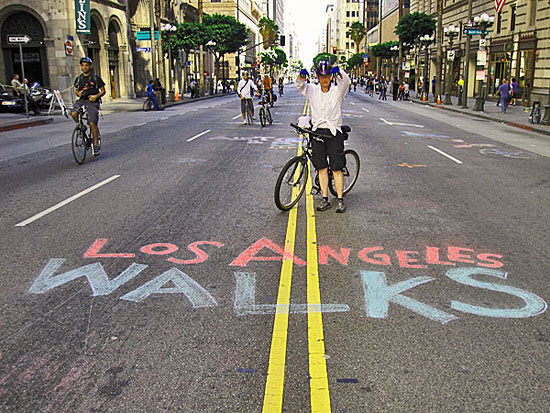
As pedestrians make their mark on CicLAvia, organizers urge cyclists to slow down and share the route.
If you go to CicLAvia this weekend, keep an eye out for Deborah Murphy.
She’ll be the one walking down the middle of the street with her Jack Russell terrier puppy, sharing her mantra with the sea of bicyclists around her:
“Slow down. Look around. Meet someone.”
Murphy, one of Los Angeles’ foremost pedestrian advocates, has walked in all three CicLAvias since the car-free street festival started here in 2010. She hopes that when the fourth gets underway at 10 a.m. on Sunday, April 15, she’ll see evidence that her message is gaining traction with the cyclists who make up 80% to 90% of the crowd.
“I want to believe it’s getting better,” said Murphy, founder of the advocacy group Los Angeles Walks and chair of the city’s Pedestrian Advisory Committee, who said she was alarmed the first time out by cyclists zooming downhill at one point along the route (where a “mandatory dismount” rule is now in effect.) “That’s not what CicLAvia’s about…This is a street party. This is not a street race.”
That sentiment is seconded by Josef Bray-Ali, the owner of the Flying Pigeon bike shop, who wrote a much-discussed blog post last April about taking his young daughter out on the route.
“This was the first time our 3-year old daughter had a chance to ride her bike in the street. The magic of that moment was ruined by CicLAvia participants on their bicycles riding by us on the left and right (while we were on the right hand shoulder of the street) going, frankly, too darn fast,” Bray-Ali wrote. “It is a perversion of the spirit of CicLAvia that the entire course is turned over to the fastest mode on the road…Let’s get this day right, Los Angeles!”
In other words, whose CicLAvia is it anyway? As the still-young event grows and changes, its identity is evolving as well—with a large and vocal cycling population reveling in having its own five-hour, 10-mile stretch of nirvana in an otherwise car-dominated metropolis, while an equally passionate walking community stands eager to claim its place on the pavement, too. The challenge of striking a balance stands as the price of success as CicLAvia comes of age.
With organizers expecting their biggest crowd of more than 100,000 on Sunday, such growing pains are proving somewhat ironic for the influential bicycle enthusiasts who started CicLAvia and view it as a key achievement in Los Angeles’ bike evolution.
“Every day of the week, we feel disrespected by cars. Let’s not be the oppressors,” said Joe Linton, a fulltime CicLAvia consultant and longtime L.A. cycling advocate. While he said that “99.9% of people have a great time at CicLAvia, whether they’re walking or biking, or 4 years old or 80 years old or 22 years old,” he said all participants need to bring mutual respect, common sense and a willingness to engage with each other.
“Everybody’s in this together,” he said. “Everybody needs to watch out.”
That said, cyclists’ passion for CicLAvia is so strong that it may tend to block out the possibilities for other ways to participate.
“We love that it’s an awesome bike event. There’s a sense that it’s so wonderfully ‘bike-y’ that people don’t realize they can do it in other ways,” Linton said. “We definitely are concerned about being inclusive.”
Pedestrians are welcome anywhere along the route, but first-timers might be especially comfortable strolling along Spring Street, Linton suggested. “It just feels really different. It’s quiet, you can see the architecture.” (Speaking of which, a new guide showcases the architectural and design high points all along the CicLAvia route.)
For novice cyclists, Linton has this advice: “Don’t bike all five hours. Stop for lunch. Don’t think of it as a workout; think of it as an exploration.”
The Los Angeles County Bicycle Coalition this week posted its own series of cyclist tips for riding safely and keeping an eye out for others.
Organizers say that the more CicLAvia becomes a street festival—with frequent musical, culinary and entertainment distractions—the slower the pace and the better for participants of all ages and experience levels.
So a key part of CicLAvia’s evolution has been to encourage dodge ball games, giant chess sets and movable photo booths, as well as musical acts and other spontaneous diversions along the route. REI will be sponsoring a climbing wall at the Hollenbeck Park hub, while the African American Firefighter Museum Hub on Central Avenue will feature museum tours, musical performances and a bike show starring the Real Rydaz Lowrider Bike Club.
Downtown, the Nature Conservancy will be raffling off two Schwinn-donated beach cruisers at 7th and Figueroa. It’s one of the organizations (others range from the Asian Pacific American Legal Center to the car-sharing service Zipcar) that will be “adopting” intersections and helping to manage bike-and-pedestrian flow through intersections which cars will be allowed to traverse intermittently. The groups will also be spreading their messages—an opportunity not lost on Los Angeles Walks, which has adopted 7th and Broadway.
The idea is to create an “intersection celebrating pedestrians,” L.A. Walks steering committee member Alissa Walker said in an email. On tap: “Lots of foot-friendly activity including double-dutch jump rope and hula hooping.” (Those inspired to help the group advance its pedestrian-friendly mission can do so even after CicLAvia is over by attending L.A. Walks’ karaoke fundraiser at Atwater Crossing on Saturday, April 21.)
Walker, a cyclist, pedestrian and blogger at Gelatobaby, concedes that she, too, was “a bit intimidated by all the bikes at previous CicLAvias.”
“But I think the best thing we can do is show all the different ways that streets can be used,” she said, such as a book club discussion she helped organize with L.A. Times architecture critic Christopher Hawthorne beside the 110 Freeway during last April’s CicLAvia.
This time out, she suggests pushing the envelope even further: “Grab some food to go and put a blanket out on the street.”
That’s right out of the playbook recommended by Flying Pigeon owner Bray-Ali, who blogged about the speeding cyclists last year. He thinks the best way to make CicLAvia evolve to become more inclusive is to harness more corporate sponsors to create crowd-pleasing digressions along the route and to find ways to make local merchants love it as much as the cyclists do. “Bring your bike and your wallet,” he suggests.
“It’s going to take work to make it work for pedestrians and people in walkers and wheelchairs, especially on the business side of things,” he said. “But that’s really when the power of the event takes over.”
And as CicLAvia grows, so do its participants, like Bray-Ali’s daughter, who’s now a road-tested CicLAvia veteran on a kiddie bike.
“Now she’s four, and she hauls,” he laughed. “Her bike is too slow for her.”
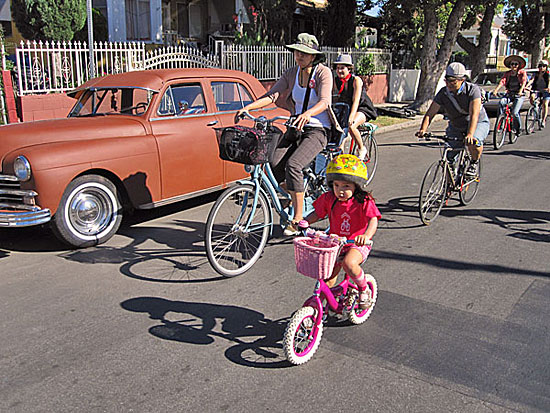
Valentina Bray-Ali leads the way to CicLAvia from her dad's Flying Pigeon bike shop. Photo/ubrayj02 via Flickr
Posted 4/10/12
Science with a seriously cool streak
April 10, 2012
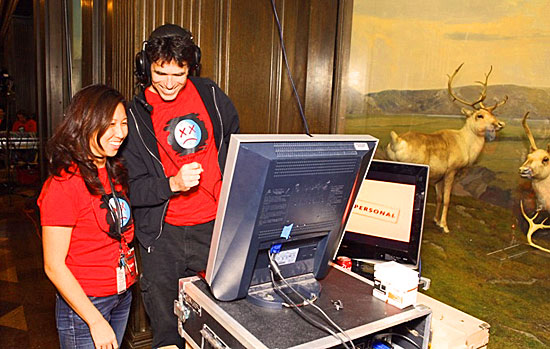
Su Oh at First Friday event, with museum tech expert Michael Wilson, right. Photo/Ryan Miller, Capture Imaging.
Meet Su Oh, the Natural History Museum’s in-house impresario.
Perhaps the only L.A. County employee whose job combines musical cool-hunting, scientific showmanship and a strong sense of theatrical occasion, Oh has been masterminding the museum’s “First Fridays” series for the past five years, presenting programs that combine top-notch lectures with cutting-edge live music.
Thanks in large part to Oh’s efforts, a species once endangered in the museum environment—the young adult—is approaching critical mass.
“At first, people were mainly coming for the concerts,” said Oh, Director of Education and Programs at the museum. “Now, they are coming for the lectures, too. The talks are really starting to rival the music in popularity.”
Oh, 40, formerly worked as an awards manager for the Recording Academy, which produces the Grammys. Five years ago, she decided it was time for a career change, but wasn’t quite sure how to use her entertainment industry experience to her advantage. She hadn’t had science-related experience since college, when she worked at Scripps Institution of Oceanography at the University of California, San Diego.
It just so happened that the Natural History Museum was seeking someone to take over First Fridays and work on boosting attendance. Oh tapped into her music industry experience to identify and book up-and-coming acts. The events began to pick up credibility among young people with an ear for innovative sounds.
Nowadays, the lecturers she schedules are rock stars in their own right, from the astronomer who “killed” Pluto to this week’s Pulitzer-winning presenter, Dr. Jared Diamond, widely known for his scholarship on everything from the birds of Papua New Guinea to the causes of global inequality. Diamond is perhaps best known for his book Guns, Germs, and Steel.
To Oh, great content is always the most important thing. Everything else follows.
“People may not know the bands and they may not know the scientists, but they trust that we are going to find good stuff for them, worth exploring at least,” she said.
Oh, whose duties also include outreach to schools and events like the annual Bug Fair, views First Fridays as “happenings” rather than just concerts or lectures. She has used projections, installation art and even a 14-foot T-Rex puppet to expand the audience’s experience while uniting them with the unique museum environment. Whatever the hook, it appears to be working. First Fridays increasingly draw large crowds, often nearing or reaching capacity.
Those crowds are not likely to dwindle soon. When Phase 1 of Exposition Light Rail Line opens on April 28, it will give the public a new route to the museum’s doorstep.
The stage is set for the Natural History Museum to celebrate its 100th birthday next year. Oh will take a more managerial role on First Fridays after this season, so she can focus more on the big picture. She envisions outdoor events that could host larger crowds while bringing nature lovers and conservationists into the fold.
That inclusivity is a hallmark of Oh’s programs. It’s also what drives her.
“I like connecting people, especially if they are not in each other’s normal realms,” she said. “The bigger gap there is to bridge, the more interested I am in it.”
You can see what the buzz is about at the latest installment of First Fridays this week.
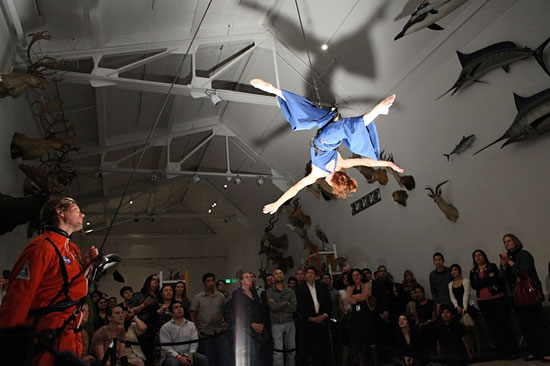
Project Bandaloop performs at the March 2 installment of First Fridays. Photo/Ryan Miller, Capture Imaging.
Posted 3/29/12
Board orders audit of assessor’s office
April 10, 2012
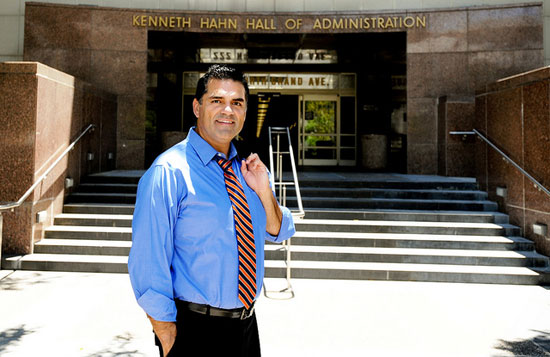
Assessor John R. Noguez blames a surprise drop in property prices for the differences in his forecasts.
Los Angeles County’s assessor came under tough criticism from the Board of Supervisors on Tuesday for producing alarmingly divergent property tax forecasts that could create unexpected headaches for hard-pressed municipalities, school districts and public safety agencies that rely on the funding.
“It’s perplexing, it’s confounding and it’s unprecedented in my time here,” said board Chairman Zev Yaroslavsky, who, with Supervisor Mark Ridley-Thomas, authored a unanimously approved motion ordering an immediate top-to-bottom audit of the assessor’s office.
Assessor John R. Noguez had disclosed to supervisors last week that the county’s 2012-2013 property tax roll would likely generate only a fraction of the net increase he’d forecasted in December, dropping from $18 billion to just $5 billion. On Tuesday, testifying before the board, Noguez blamed the disparity on what he said was a surprising plunge in property values during the final months of last year, with an average 5% tax reduction expected on more than 500,000 parcels.
But Noguez’s explanations, along with those of his chief of staff, seemed only to fuel the supervisors’ concerns about the performance of the assessor’s office, which in recent months has been confronted with allegations that it gave special treatment to certain property owners. Noguez, a 25-year veteran of the assessor’s office who was elected to the top job in 2010, has insisted he’s acted properly and said Tuesday he welcomes a comprehensive review of his office by the county’s auditor-controller.
During the board meeting, Noguez was not asked directly about that controversy. But the tenor of the questioning—and the wording of the audit motion itself—suggested that the supervisors had broader concerns than the revenue forecasts.
“It is imperative that the Board of Supervisors, the governing bodies of other local public agencies and the public have confidence in the Assessor to accurately, efficiently and impartially administer the property assessment process,” Yaroslavsky and Ridley-Thomas wrote in their motion. “The public must be ensured that adequate controls are in place to safeguard the reliability and integrity of the system.”
Although it’s not unusual for variations to exist among property tax forecasts, what made this one so “shocking,” in the words of Supervisor Don Knabe, was that differences between the projected revenue increases were so big—from 1.77% in December to .49% this month. For the county, that represents a potential drop of more than $50 million at a time when the county and other municipalities are hammering out their budgets.
“It’s not simply a matter of numbers but, in fact, real impacts that could adversely affect real human beings,” Ridley-Thomas said.
Chief Executive Officer William T Fujioka, who called the size of the disparities “unprecedented,” said the new audit could show that the assessor’s office got it wrong and that the spread is smaller than currently predicted. “I’m confident [that] through the auditor-controller’s efforts that we’ll get a more accurate picture,” he said.
If the $50 million drop in revenue should hold true, Fujioka said, “I’m confident we’ll be able to address this without any significant reduction in county services.”
That may not be the case elsewhere, as Supervisor Michael D. Antonovich pointedly noted. “This,” he said, “is going to be a severe tsunami to the schools and cities.”
The city of Los Angeles’ chief budget official, Miguel Santana, said in an interview that the difference in forecasts means a potential loss of more than $18 million—“a significant change in terms of how tight our budget is…We’re trying to find solutions to mitigate that gap.” The city is confronting a budget deficit of $222 million.
Santana, like L.A. County officials, said he learned belatedly about that gap only after contacting Noguez for an update. Veterans of the city’s budget office, he said, were stunned by the sharp variances between the earlier and latest forecast. “This is the first time they’ve seen anything so dramatically different.”
Posted 4/10/12
Pay your fines with peanut butter
April 5, 2012
Feeding the hungry isn’t just the right thing to do; it’s also a smart way for bookworms to pay off their late fees at the Beverly Hills Public Library during “Food for Fines Week.” From April 9 through April 14, past-due fines will be reduced or eliminated for library members who bring items for donation to the Westside Food Bank.
The library borrowed the idea of combining fine forgiveness with a food drive three years ago from programs in other cities and states. Each year the Beverly Hills event brings in several large barrels of food for distribution to the homeless, low-income families and others in need.
“People have really taken to the idea of getting a little off their account while helping others,” said Karen Buth, library services manager.
The library will accept most non-perishable foods. Healthy options are encouraged, but food in glass jars should be left at home (except for baby food). Up to five dollars is deducted from the member’s outstanding balance for each item donated. Additionally, children 18 and under can simply show up, even without canned goods, and have their fines waived at check out. The promotion does not apply to fines for lost/damaged items or accounts that have gone to the library’s collection agency.
What if you’re the kind of library patron who’d never dream of returning a book late? No problem; your canned goods donation is welcome, too.
The Beverly Hills Public Library is located at 444 North Rexford Drive, and is open Monday through Thursday from 10 a.m. to 8 p.m., Friday and Saturday from 10 a.m. to 6 p.m. and Sunday from noon to 5 p.m.
Posted 4/5/12
A bus to new beginnings in baseball
April 4, 2012
When you go out to the ballpark this landmark season, don’t get caught in a squeeze play when it comes to traffic and parking—leave the car at home and take Metro’s Dodger Stadium Express, back again for 2012 home games to give ticket holders a free lift between Union Station and Dodger Stadium.
The regular season home opener is at 1:10 p.m. on Tuesday, April 12, against the Pirates. Check out the rest of the schedule here.
Posted 4/4/12
Stopping a danger in the sand
April 4, 2012
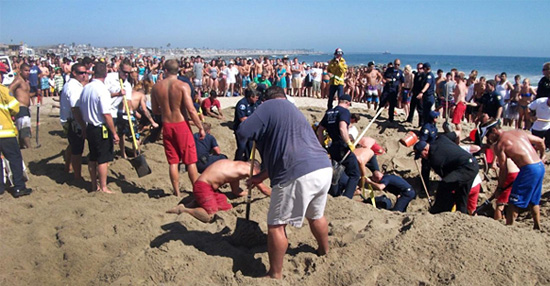
Rescuers work feverishly to uncover a teen in Newport Beach who was buried for 30 minutes but survived.
The county’s new beach ordinance may have launched more than its share of wisecracks about allegedly outlaw Frisbees, but lifeguards say that at least one of the less-discussed changes could save lives—and that’s no joke.
The new law, which won final approval from the Board of Supervisors on Tuesday, bans the digging of holes deeper than 18 inches to avert dangers not widely known to beachgoers, said Los Angeles County Lifeguard Section Chief Mickey Gallagher.
“In my 40-year career, people have been badly injured and even killed as a result of sand tunneling,” he said. “This is about a safety hazard. It isn’t about little kids with plastic shovels digging a little hole in the sand.”
Last August, for instance, a teenager was buried alive for more than 30 minutes in Newport Beach. The then-17-year-old boy was building a tunnel when the sand collapsed around him. He survived, several feet below ground, only because he had managed to wiggle his head a little as the sand poured in around him, creating a slight air pocket that kept him alive long enough for emergency crews and bystanders to get to him.
Two months before that, in June 2011, a Northern California teenager on a beach outing with a church group was permanently disabled after being buried for more than 10 minutes when a sand tunnel collapsed on him.
In the same week, according to Los Angeles County lifeguard records, a 10-year-old boy in Manhattan Beach was rescued from a similar situation—only the top of the boy’s head was showing when the lifeguard found him. He’d been lying on his back in a hole, tunneling laterally, and had ignored a prior warning to stop digging because it was dangerous.
Nine months earlier, on Labor Day weekend, a 3-year-old toddler was taken by air ambulance from Zuma Beach to Harbor-UCLA Medical Center after she crawled into a sand hole that had collapsed on her, county lifeguard records show.
And two months before that, on July 25, 2010, an 11-year-old boy burrowing in Manhattan Beach was buried for five minutes as more than a dozen beachgoers, emergency workers and lifeguards tried frantically to extricate him. Lifeguards later said that the only reason they even located him was that his cousin had run, screaming, for help and one of his rescuers had glimpsed a patch of his blue swim trunks as they dug blindly under the sand’s surface. By the time he was pulled free, his lips were blue and he had stopped breathing; he vomited sand after a physician who happened to be at the scene administered mouth-to-mouth resuscitation.
“Sand is really unstable, even when it’s hard-packed,” said Gallagher. “Every year, someone will try to dig a deep hole, or tunnel in from a steep berm after a high tide and get into trouble. Some people actually come down to the beach with big shovels, like you use in construction.
“People think they can make a tunnel or a cave, and to the untrained eye, the sand may seem fine because it’s wet. But without support, those tunnels will collapse, and sand is extremely heavy. And once someone is buried, it’s extremely hard to find them. And there’s no oxygen down there.”
The revisions to the beach ordinance make a number of other clarifications to the existing rules for recreation at the beach. Among other things, they make clear for the first time that Frisbees and footballs are allowed on the beach, albeit with certain restrictions. (Basically, you can do it anytime except when it endangers someone or a lifeguard deems it unsafe.)
Inaccurate press reports initially drew criticism of the changes, including the ban on digging, which was derided as meddlesome fun-killing. But Beaches & Harbors Director Santos Kreimann says lifeguards requested the digging restrictions so they could have legal backup in preventing a problem they’ve informally been guarding against for generations.
Beyond dangers to the diggers, Kreimann said, holes in the sand also create a hazard for emergency workers, who are jolted by them when they transport people with neck and back injuries.
“The bottom line is: Have a good time and play in the sand if you want to,” Kreimann said. “But don’t dig more than knee-deep, and if you make a hole, fill it back up.”
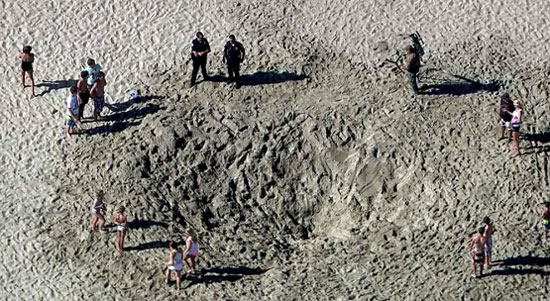
All that's left: the hole in Newport Beach where sand swallowed a 17-year-old boy. Photo/Los Angeles Times
Posted 4/3/12




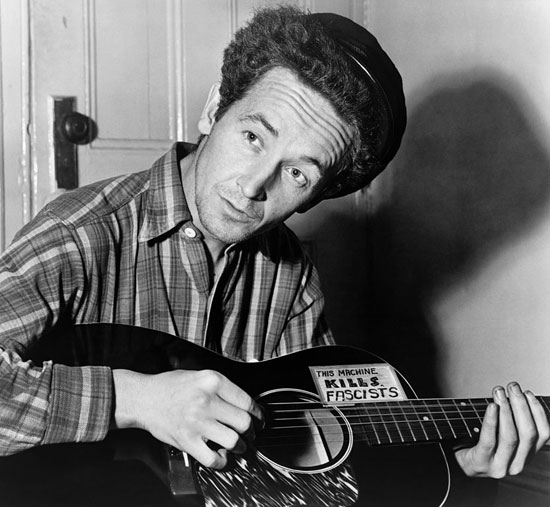
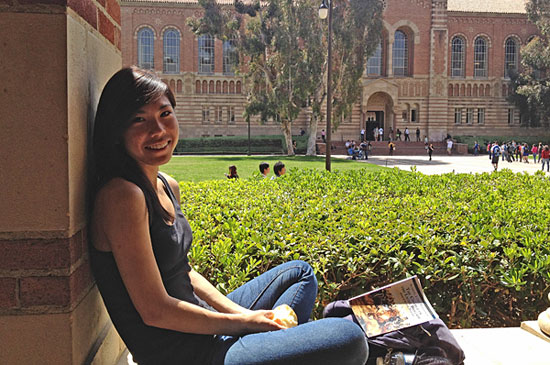
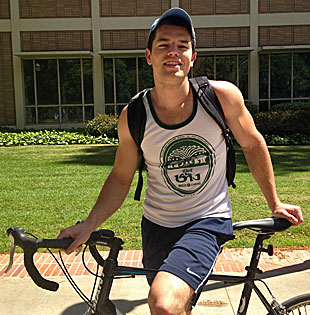
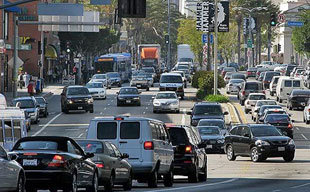
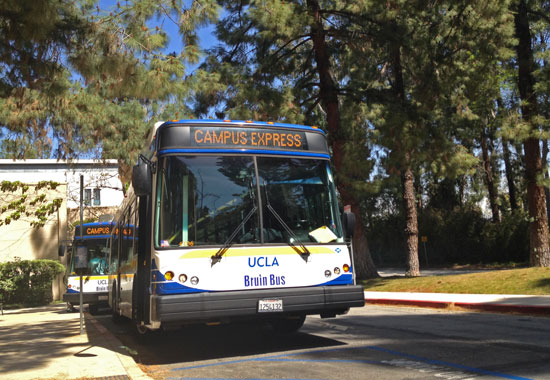
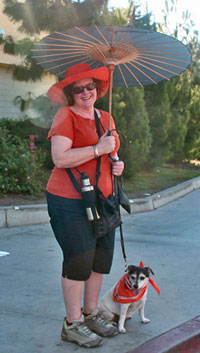
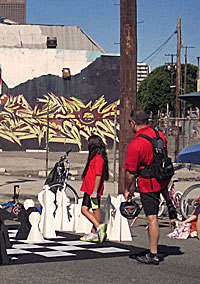







 Check for the latest closure information
Check for the latest closure information








